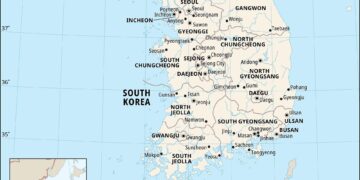In a significant display of military presence amid escalating tensions on the Korean Peninsula,a U.S.aircraft carrier has arrived in South Korea just days after North Korea conducted a series of missile test launches. The deployment underscores the U.S. commitment to its defense alliance with South Korea and aims to deter any potential aggression from the North. The arrival of the USS Ronald Reagan, accompanied by a strike group, serves as a clear message to Pyongyang, reflecting ongoing concerns over its missile development programs and provocative actions. This move coincides with heightened vigilance in the region as analysts and military officials closely monitor North Korea’s next steps and the implications for regional security and international relations.
US Aircraft Carrier’s Arrival Marks a Strategic Response to North korea’s Provocations
The recent arrival of a US aircraft carrier in South Korea underscores a sharp escalation in military readiness in response to North Korea’s provocative actions, particularly its recent missile tests. This strategic positioning is aimed at reassuring regional allies and demonstrating the United States’ commitment to maintaining peace and stability in Northeast Asia. The aircraft carrier, a floating symbol of naval power, is equipped with advanced weaponry and aircraft, allowing it to conduct a range of operations, from surveillance to potential airstrikes. The presence of such formidable military assets serves not only as a deterrent against further North Korean aggression but also strengthens the collective security posture of US allies in the region.
Military analysts note several key implications of this deployment:
- Increased Deterrence: the carrier’s presence is designed to dissuade North Korea from future antagonistic actions.
- Allied Confidence: South Korea and Japan are likely to feel more secure with US forces visibly stationed nearby.
- Operational Readiness: The carrier could facilitate joint exercises and rapid response to any eventualities.
Furthermore, this situation raises significant geopolitical stakes, as the carrier is part of a broader framework of military cooperation among US allies. It aligns with other maneuvers and deployments in the Pacific, indicating a unified front against any threats posed by North Korea. The ongoing dialog between military capabilities and diplomatic efforts will be crucial in navigating the complexities of this evolving landscape, with both the US and its allies seeking a balance between show of force and diplomatic engagement.
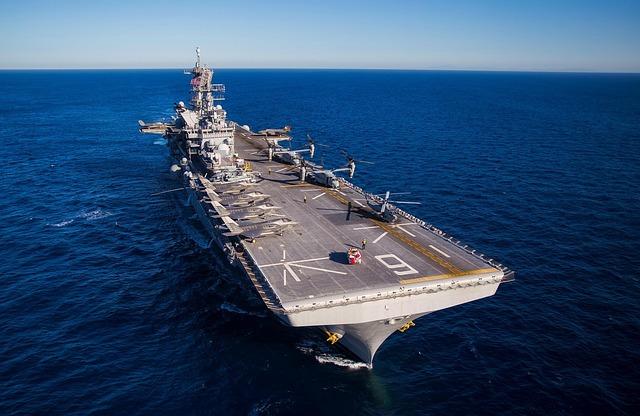
Analyzing North Korea’s Missile Tests and Their Implications for Regional Stability
The recent missile tests conducted by North Korea have once again raised alarms about the stability of the Korean Peninsula and its surrounding regions. Observers are particularly concerned about the technological advancements that North Korea has demonstrated, as these capabilities not only threaten South Korea but also pose challenges to japan and the U.S. military presence in the region. The implications of these tests extend beyond mere military posturing; they signal a shift in geopolitical dynamics and may compel nations to reconsider their defense strategies and alliances. Here are some key points to consider:
- escalating Tensions: North Korea’s missile launches are perceived as direct challenges to both international norms and regional security frameworks.
- Military Readiness: The tests prompt a reevaluation of military readiness not only in South Korea but throughout the Asia-Pacific region.
- Diplomatic Strains: Continued aggression could hinder diplomatic efforts aimed at denuclearization and peace negotiations.
In response to North Korea’s provocative actions, the arrival of a U.S. aircraft carrier in south Korea is indicative of an increased commitment to regional stability and collective defense. This presence serves multiple purposes: it acts as a deterrent to further North korean aggression, reassures allies of the U.S. commitment to mutual defense, and reflects ongoing military cooperation between the U.S. and South Korea. To contextualize the current situation, the following table summarizes the recent missile tests and the corresponding reactions from key stakeholders:
| Date of Test | Type of Missile | Reaction |
|---|---|---|
| September 1, 2023 | Ballistic Missile | Condemnation from U.S. and Japan |
| September 10, 2023 | Cruise Missile | Increased military drills by South Korea |
| September 12, 2023 | Surface-to-Air Missile | Emergency UN Security Council meeting |
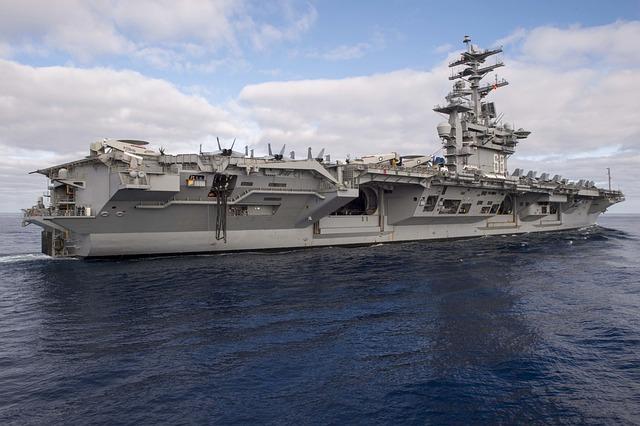
The Role of US Military Presence in deterring Aggression in east Asia
The deployment of US military assets, such as aircraft carriers, plays a critical role in maintaining stability in East asia. The visible presence of these forces serves as a deterrent against potential aggressors, particularly in the face of North Korea’s ongoing missile tests and military provocations. The strategic positioning of US naval power not only underscores the United States’ commitment to its allies in the region but also instills a sense of reassurance among those nations.The following points highlight the impact of this military presence:
- Deterrence of North Korean Aggression: A strong US military presence diminishes the likelihood of hostile actions from Pyongyang.
- Strengthened Alliances: Regular military exercises and deployments bolster ties with regional allies like South Korea and Japan.
- Rapid Response Capability: Aircraft carriers provide a versatile platform for quick military responses to emerging threats.
In recent years, geopolitical tensions have escalated due to North Korea’s nuclear ambitions and missile development programs.The presence of US military forces acts as a signal that any attempts at aggression will be met with significant countermeasures. Moreover, it helps to uphold a balance of power in the region, thereby contributing to a broader framework of security that extends beyond the Korean Peninsula. The table below illustrates some of the key aspects of the US military presence:
| Key Aspect | Impact |
|---|---|
| Military Exercises | Enhance preparedness and interoperability with allies. |
| Strategic Deterrence | Reduces risks of miscalculations by adversaries. |
| Humanitarian Assistance | Provides immediate support during crises in the region. |
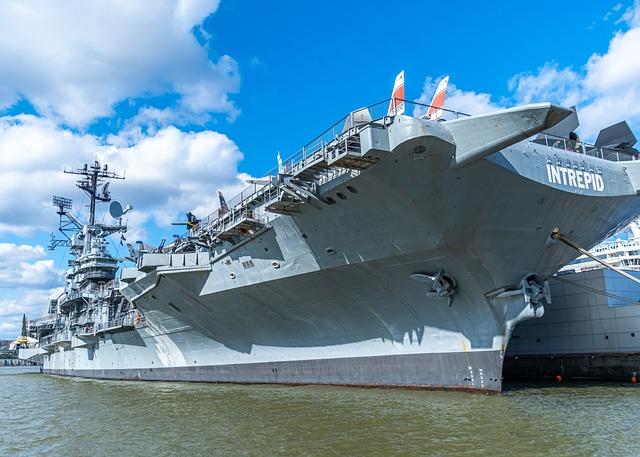
Evaluating the Impact on US-South Korea Defense Cooperation
The recent deployment of a US aircraft carrier in South Korea marks a significant moment in the evolving landscape of defense cooperation between the two nations, particularly in light of North Korea’s continued missile tests. This military maneuver underscores the commitment of the United States to bolster the security of its allies in the region and serves as a deterrent against potential aggression from Pyongyang. The presence of such naval power not only enhances joint operational capabilities but also reinforces the strategic partnership, which is critical in a time of increasing tension on the Korean Peninsula.
Several factors contribute to the strengthening of US-South korea defense cooperation in this context:
- Mutual Security Obligations: The US-south Korea alliance is grounded in a mutual defense treaty that obligates the US to respond to threats against South Korea.
- Increased Military Exercises: Joint drills and training exercises have ramped up, allowing both nations to enhance interoperability and readiness.
- Intelligence Sharing: Enhanced interaction and intelligence-sharing mechanisms are vital for preemptive action against North Korean provocations.
- Regional Stability Efforts: strategic deployments aim to reassure not just South korea but other allies in the region,promoting a collective security framework.
| Key Elements | Implications for Cooperation |
|---|---|
| US Naval Presence | Increased deterrence against North Korea |
| Joint Military Exercises | Enhanced readiness and tactical proficiency |
| Diplomatic Dialogues | Strengthened regional alliances |
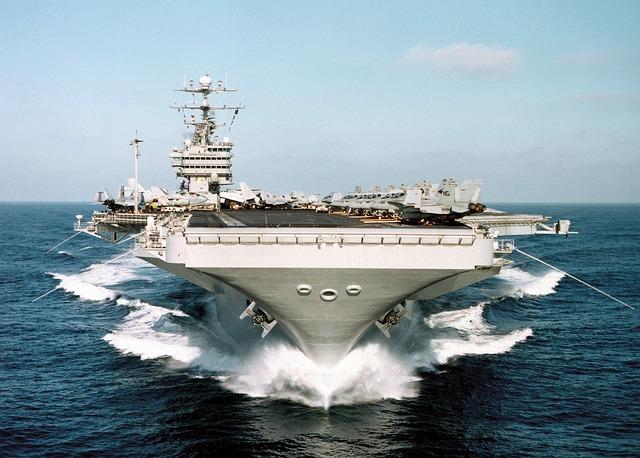
Recommendations for Diplomatic Engagement Amid Rising Tensions
In light of escalating tensions, it is crucial for diplomatic channels to remain open and functional. Engagement through diplomacy should prioritize the following strategies to mitigate confrontations and foster dialogue:
- Initiating Backchannel Communications: both the U.S. and North Korea should harness discreet communication lines to share concerns and intentions, reducing the likelihood of misunderstandings.
- Engaging Regional Allies: Involving South Korea and Japan in discussions can create a unified front that amplifies the voices of regional stakeholders, enhancing the effectiveness of diplomatic efforts.
- Scheduling Multilateral Talks: Coordinated talks involving international organizations could serve as a platform for North Korea to articulate its needs while addressing security concerns from its neighbors.
Moreover, it is paramount that diplomatic initiatives focus on the long-term implications of military posturing. Considerations should include:
| Action | Potential Outcome |
|---|---|
| Promoting Cultural Exchanges | Build trust and mutual understanding between nations |
| Implementing Economic Incentives | Encouraging North Korea to engage in constructive behavior |
| Strengthening Humanitarian Efforts | Fostering goodwill and reducing hostilities |
Looking Ahead: The Future of Security Alliances in the Face of North Korean Threats
The evolving security landscape in the Asia-Pacific region, particularly in response to North Korea’s continued missile tests, necessitates a robust reassessment of existing alliances. As regional players grapple with increasing uncertainty, the United States remains a pivotal force, reaffirming its commitments through visible military presence and joint exercises with allies like South Korea. This strategic posture not only serves as a deterrent but also emphasizes the importance of multilateral cooperation. Key aspects to consider include:
- Strengthened Bilateral Relations: Enhancing military collaboration with South Korea and Japan.
- Expanded Military Drills: Conducting more frequent and larger-scale joint exercises to demonstrate readiness.
- Engaging Regional Partners: Involving ASEAN countries to create a broader security framework.
As alliances adapt to face these multifaceted threats,a focus on technology and intelligence sharing will also be crucial. modern security challenges require not only military might but also innovative solutions and real-time details exchanges to counteract North Korea’s aggressive posture effectively. The table below outlines some strategies that can be employed to enhance cooperation and effectiveness:
| strategy | Description |
|---|---|
| Cybersecurity Initiatives | Joint efforts to protect critical infrastructure from cyber threats. |
| Intelligence Sharing | Real-time information exchanges to counteract North Korean tactics. |
| Humanitarian Efforts | Collaborative programs to address regional issues beyond military concerns. |
To Wrap It Up
the arrival of the U.S. aircraft carrier in South Korea marks a significant moment in the ongoing tensions on the Korean Peninsula. Following North Korea’s recent missile test-firings, this deployment underscores the United States’ commitment to regional stability and deterrence against potential aggression from the North. As military exercises and strategic collaborations continue, the situation remains dynamic, with both South Korea and its allies closely monitoring developments. The response from North Korea, alongside global reactions, will be pivotal in shaping the next steps in this high-stakes geopolitical landscape. As tensions persist and diplomatic efforts evolve, the implications of this military presence will be closely watched by observers around the world.


